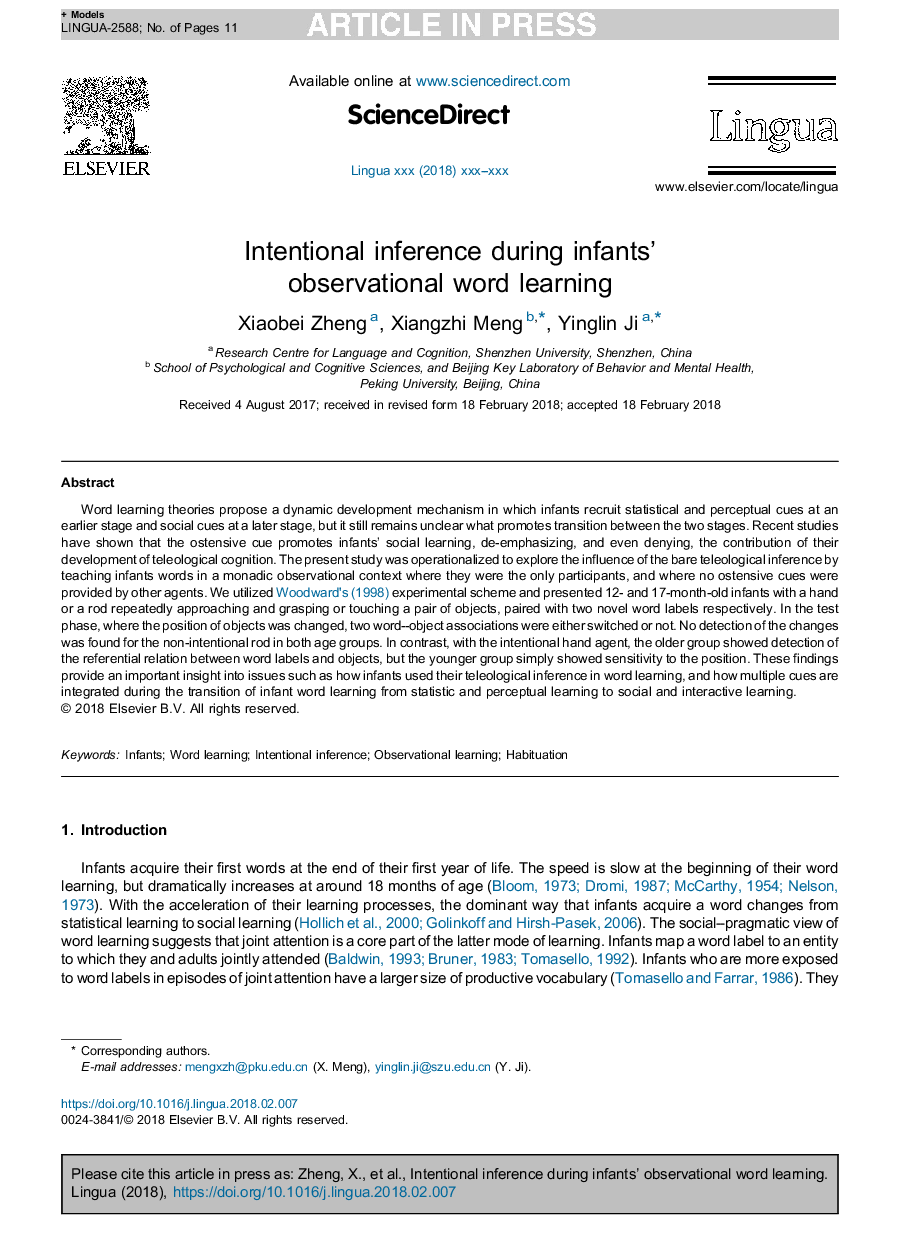| کد مقاله | کد نشریه | سال انتشار | مقاله انگلیسی | نسخه تمام متن |
|---|---|---|---|---|
| 7298350 | 1475011 | 2018 | 11 صفحه PDF | دانلود رایگان |
عنوان انگلیسی مقاله ISI
Intentional inference during infants' observational word learning
ترجمه فارسی عنوان
استنتاج ذهنی در یادگیری کلمات مشاهدات نوزادان
دانلود مقاله + سفارش ترجمه
دانلود مقاله ISI انگلیسی
رایگان برای ایرانیان
کلمات کلیدی
نوزادان، یادگیری کلمه، استنتاج ذاتی، یادگیری بصری، حبابی
ترجمه چکیده
نظریه های یادگیری کلمه یک مکانیسم توسعه پویایی را پیشنهاد می دهند که در آن نوزادان در یک مرحله زودتر و نشانه های اجتماعی در مراحل بعد استخدام می کنند که نشانه های آماری و ادراکی را در بر دارد، اما هنوز مشخص نیست که چه چیزی باعث انتقال بین دو مرحله می شود. مطالعات اخیر نشان داده است که نشانه اشعار، یادآوری اجتماعی نوزادان را تقویت می کند، تاکید و حتی انکار، سهم توسعه خود را از شناخت تئولوژیک. مطالعه حاضر برای کشف تأثیر استنتاج تئولوژیک بیحرکتی با آموزش کلمات شیرخواران در یک مفهوم مشاهده مونادی انجام شد که در آن آنها تنها شرکت کنندگان بودند و جایی که هیچ نشانه های تنفسی توسط عوامل دیگر ارائه نشد. ما از طرح آزمایشی وودوارد (1998) استفاده کردیم و نوزادان 12 و 17 ماهه را با یک دست یا میله ای که بارها و بارها مکررا در حال نزدیک شدن و لمس کردن یک جفت اشیاء بود، به دو زبانه دو کلمه جدید زدیم. در مرحله آزمایشی، جایی که موقعیت اشیا تغییر می شد، دو انجمن مربوط به کلمه-شی یا تغییر یافت یا خیر. هیچ گونه تشخیص تغییرات برای میله غیر عمدی در هر دو گروه سنی یافت نشد. در مقابل، با عامل دستی عمدی، گروه مسن تر نشان دادند که رابطه مرجع بین برچسب های کلیدی و اشیاء وجود دارد، اما گروه جوانتر به سادگی حساسیت به موقعیت را نشان می دهد. این یافته ها یک بینش مهم در مورد مسائلی مانند نحوه استفاده از استنتاج تئولوژیکی کودکان در یادگیری کلمه و نحوه چندین نشانه در انتقال یادگیری لغات کودک از یادگیری آماری و ادراکی به یادگیری اجتماعی و تعاملی را در بر می گیرد.
موضوعات مرتبط
علوم انسانی و اجتماعی
علوم انسانی و هنر
زبان و زبان شناسی
چکیده انگلیسی
Word learning theories propose a dynamic development mechanism in which infants recruit statistical and perceptual cues at an earlier stage and social cues at a later stage, but it still remains unclear what promotes transition between the two stages. Recent studies have shown that the ostensive cue promotes infants' social learning, de-emphasizing, and even denying, the contribution of their development of teleological cognition. The present study was operationalized to explore the influence of the bare teleological inference by teaching infants words in a monadic observational context where they were the only participants, and where no ostensive cues were provided by other agents. We utilized Woodward's (1998) experimental scheme and presented 12- and 17-month-old infants with a hand or a rod repeatedly approaching and grasping or touching a pair of objects, paired with two novel word labels respectively. In the test phase, where the position of objects was changed, two word-object associations were either switched or not. No detection of the changes was found for the non-intentional rod in both age groups. In contrast, with the intentional hand agent, the older group showed detection of the referential relation between word labels and objects, but the younger group simply showed sensitivity to the position. These findings provide an important insight into issues such as how infants used their teleological inference in word learning, and how multiple cues are integrated during the transition of infant word learning from statistic and perceptual learning to social and interactive learning.
ناشر
Database: Elsevier - ScienceDirect (ساینس دایرکت)
Journal: Lingua - Volume 207, May 2018, Pages 38-48
Journal: Lingua - Volume 207, May 2018, Pages 38-48
نویسندگان
Xiaobei Zheng, Xiangzhi Meng, Yinglin Ji,
